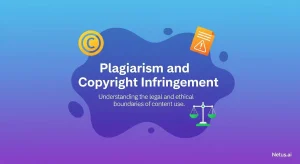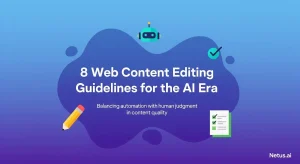6 Writing Tricks to Revitalize Your Old Content Efficiently
Ashley Merit
Content writer and editor for Netus.AI
Table of Contents
6 Writing Tricks to Revitalize Your Old Content Efficiently. In today’s fast-paced digital world, it is vital for writers to keep their content updated and engaging. Whether it’s for online businesses, fiction, news articles, or essay writing, maintaining relevance is essential in capturing and retaining the audience’s attention. As your website or business grows, new followers might miss earlier creative endeavors which deserve recognition. To resolve this, writers can employ various techniques to breathe new life into their existing content.
This article delves into six practical tips regarding the revitalization of your previously published work, ensuring that it stays fresh and appealing to readers. Implementing these tips will not only enhance the overall quality of your content but also provide a better reading experience for your growing audience.
Key Takeaways
- Employing various techniques can keep your content updated and engaging
- Revitalizing earlier works helps attract new followers.
- Enhanced content quality promises a better reading experience for your audience.
1. Experiment with Your Writing Voice
Changing your writing voice can refresh old content, much like the appeal of cover songs. Try rewriting your article with an enthusiastic tone, or take a more cautious and skeptical approach. Adopt the persona of a character, each with their unique personality.
If you write for a specific brand, adjust your voice to match their established tone and character. This adaptation will create an organic union of your content with their signature style. For those new to writing, exploring different tones and voices early on will help you develop a unique style that works for you. It’s okay to imitate a role model’s writing style during this exploration, but refrain from outright copying – your goal is to adapt, not plagiarize.
Finding and mastering your writing voice may initially be challenging, but once accomplished, it will ensure a constant stream of original and engaging content. Experimenting with your voice helps keep readers interested and can invigorate the emotions and experiences behind the words you write. Remember, your voice and tone play a crucial role in connecting with the audience and conveying information effectively.
With practice, you can confidently and knowledgeably adapt your writing voice to suit various contexts, ensuring that your content remains fresh and engaging in the ever-evolving world of writing.
2. Play with Words
In content creation, it’s vital to present ideas using various writing techniques and language styles to keep the content engaging and original. Swapping words or using synonyms might not be enough to maintain the readers’ interest. Instead, consider employing creative methods such as altering the narrative voice, using metaphors, hyperbole, irony, sarcasm, or employing epithets. This way, you avoid the risk of appearing lazy and unoriginal.
Being a content writer means selling your originality, creativity, and persuasiveness. Plagiarism undermines these qualities, which is why it should be strictly avoided. With modern technology providing us with artificial intelligence-based plagiarism checkers, it’s easier than ever to catch even the slightest hint of plagiarized content. To preserve your credibility, always strive to create original content.
Rewriting, though often perceived as a basic writing task, holds great importance in producing quality content. Incorporating multiple sources and ideas into your writing demonstrates research skills, whereas copying a single source is considered plagiarism. Enhancing your content with a diverse vocabulary and language styles while conveying the same message is a skill you should practice and develop. Familiarizing yourself with synonyms and resources like a thesaurus can be beneficial in this process.
When it comes to formatting, presentation, and readability, try applying the following techniques:
- Break down paragraphs: Limit them to 2-3 sentences, making it easier for readers to digest the information.
- Use bullet points: Employing bullet points can help organize details and create a more straightforward reading experience.
- Bold essential phrases: Highlight key points to grab the reader’s attention as they skim through the content.
- Maintain a flow: Ensure that your sentences are well-paced and grammatically correct to improve your audience’s overall experience.
By utilizing these writing tricks, you can breathe new life into your content, ensuring originality and captivating your readers’ interests.
3. Eliminate Unnecessary Content and Reorganize
Writers are often paid based on the number of words they produce, which can lead to the temptation of extending sentences or including irrelevant content to increase the word count, known as fluff. However, this practice can negatively impact the quality of the writing. It is essential to remove superfluous content and replace it with valuable information to maintain the reader’s interest.
One challenge posed by the internet is the decrease in attention span among readers. With the abundance of available information, it is crucial to ensure content is concise and easy to skim. To make content more accessible, consider the following steps during the editing process:
- Examine the writing structure and reorganize paragraphs to only include 2-3 sentences. This makes it simpler for readers to quickly grasp the main points.
- Utilize various formatting elements, such as bold text, bullet points, and tables, to emphasize critical information and improve readability.
- Revisit the content with a focus on clarity, flow, and coherence, refining the overall structure and making necessary edits.
Addressing these aspects of the writing process helps enhance readability and ensure your writing effectively conveys the desired information. By removing fluff and restructuring, writers can create better content that stands out and keeps readers engaged, regardless of their field or the platform they work on.
4. Keep the Point
In the process of rewriting your blog post, remember that your primary goal is to convey ideas effectively. To help achieve this, briefly review your old content and identify the main points. Creating a bullet-point list can be quite useful in doing so. This allows you to maintain focus on the core concepts, eliminating distractions while driving value and traffic to your post. By having clarity on these essential points, you can naturally rewrite the content in a way that engages readers and ensures a smooth flow.
5. Focus on Rewriting Sections, Not Individual Sentences
When updating and repurposing content, it is essential to avoid getting caught up in rewriting each sentence. Instead, concentrate on larger text segments, such as paragraphs. This approach ensures a more coherent and meaningful rewrite, as focusing on individual sentences can lead to losing the context and overall message. For example, in argumentative content, each sentence contributes to a broader conclusion, making it crucial to maintain that context.
Taking a holistic view of paragraphs and their underlying ideas or arguments is more effective than attempting to reword every single phrase. This process can be compared to translating text from one language to another, where literal translation often results in confusion due to differences in colloquialisms and grammar structures. Adaptation is key, which can only be achieved effectively by rewriting complete sections, promoting a cohesive repurposing of evergreen content.
6. Sources: Embrace Abundance
Incorporate your original content as the foundation for revisions. As circumstances evolve and new data emerges, don’t hesitate to update and enrich your work. When there are no strict word count constraints, feel free to include anything relevant and valuable.
Don’t be afraid to integrate personal insights and remarks, as they can boost your content’s timeliness. Pruning unnecessary text not only enhances the overall readability, but also clears space for the addition of more quotes and sources, strengthening your article with diverse perspectives.
Key Takeaways
Rewriting content might seem challenging initially, but as you practice, it becomes similar to crafting original content. The primary difference is that you’re representing the source material. A consistent approach can make the process more manageable and efficient.
- Use the same research methodology as when writing new content.
- Focus on the essence of the information while being creative with your language.
- Incorporate various formatting options like tables, bullet points, and bold text for better readability and improved presentation.
Frequently Asked Questions
How can I breathe new life into already published blog articles?
A great way to revitalize old blog posts is by updating outdated facts, incorporating fresh visuals such as images or videos, and adding internal and external links. You can also restructure the content or repurpose it into a new format like turning a blog post into an infographic, podcast, or video tutorial.
What techniques help make older web articles more appealing?
To make older web articles more engaging:
- Rewrite headlines or titles to be more captivating and SEO-friendly
- Utilize effective revision strategies
- Improve readability through sentence flow and concise statements
- Integrate trending or relevant keywords to enhance SEO performance
How does repurposing content benefit my content marketing strategy?
Repurposing content can help you reach a wider audience, especially if the new format appeals to different preferences. Repurposed content can also boost your SEO efforts and increase the chances of audience engagement over multiple platforms.
What are recommended approaches for updating stale content for modern readers?
When updating outdated content, consider:
- Verifying and updating facts, statistics, or links
- Identifying and replacing outdated information
- Adding fresh examples or case studies
- Formatting the content with bullet points, headings, or images for readability
How should I preserve the original voice while refreshing older articles?
To maintain the original tone of your old articles, first identify the overall tone of the content (e.g., formal, casual, or humorous) and ensure that your updates align with that tone. Moreover, try to understand the author’s writing style and continue to convey their thoughts or ideas consistently.
What techniques can improve existing content’s SEO value?
Improving the SEO value of existing content involves:
- Conducting keyword research and naturally incorporating relevant keywords
- Implementing meta descriptions and title tags with related keywords
- Including internal or external links with keyword-rich anchor text
- Enhancing content readability and user experience
- Sharing the updated content on social media or your network to attract more visitors

The shortcomings of content generated by AI | NetusAI
Discover why fast, high-volume AI content often fails to deliver real results. Learn about the crucial missing feedback loop and how implementing performance tracking can transform your AI content strategy.

The illusion of AI: Your system's intelligence gap | NetusAI
Stop wasting marketing spend! Most AI tools don’t learn from results, causing content stagnation and low engagement. Discover why your generative AI isn’t getting smarter and what system actually learns and optimizes content.

Plagiarism and copyright infringement | NetusAI
Learn the distinct differences between plagiarism and copyright infringement. Understand the ethical and legal implications and get practical strategies for avoiding both academic and creative work with NetusAI.

Tips and strategies for mobile content marketing | NetusAI
Optimized for mobile-first indexing, learn 5 essential strategies to capture attention, enhance engagement and drive leads and sales with your mobile content marketing.

Web content editing guidelines for the AI era | NetusAI
Review web content editing guidelines for the AI era. Learn how to edit AI-generated content, ensure authenticity and optimize for SEO and readability.

Explaining AI pattern recognition | NetusAI
AI pattern recognition enables machines to identify trends for diverse applications, from detecting plagiarism to fraud. Discover its processes, models and real-world benefits.
